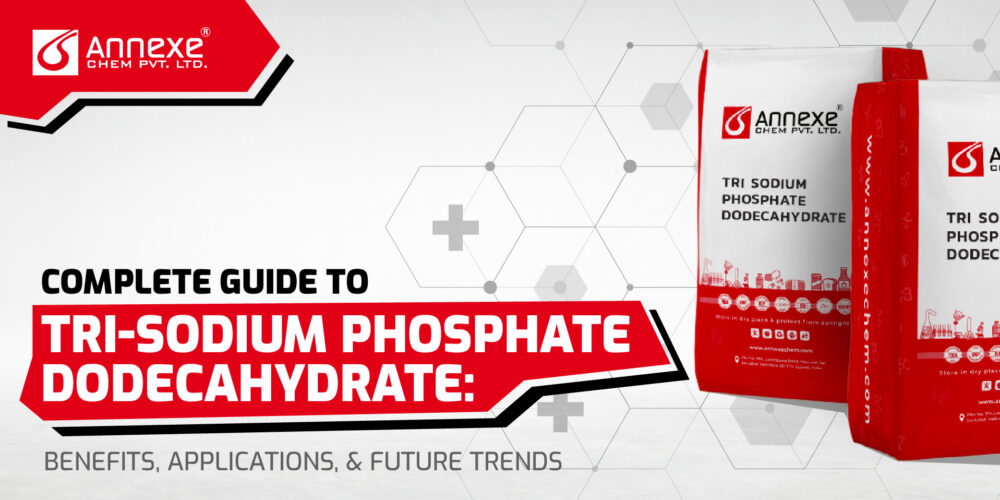Complete Guide to Tri-Sodium Phosphate Dodecahydrate: Benefits, Applications, & Future Trends - Annexe Chem Pvt Ltd
Complete Guide to Tri-Sodium Phosphate Dodecahydrate: Benefits, Applications, & Future Trends

- July 17, 2024
- By Akshita Patel
Imagine a versatile compound that seamlessly integrates into your daily life, making your cleaning products more effective, enhancing the quality of your food, and even improving the water’s safety. This multifaceted marvel is Tri-Sodium Phosphate Dodecahydrate (TSP), a compound that quietly works behind the scenes in various industries, contributing to both household and industrial processes. Whether you’re a curious homeowner, a chemistry enthusiast, or a professional in the field, understanding TSP opens the door to appreciating its invaluable role in our modern world. Dive in with us as we unravel this unassuming yet indispensable substance’s science, applications, and future potential.
What is Tri-Sodium Phosphate Dodecahydrate?
Tri-Sodium Phosphate Dodecahydrate, commonly abbreviated as TSP, is an inorganic compound with the chemical formula Na₃PO₄·12H₂O. It consists of three sodium (Na⁺) ions, one phosphate (PO₄³⁻) ion, and twelve molecules of water of hydration (dodecahydrate). This hydrated form is what makes TSP particularly effective in various applications, as the water molecules play a crucial role in its solubility and reactivity.
The crystalline structure of TSP dodecahydrate is characterized by a network of sodium and phosphate ions stabilized by the hydrogen-bonded water molecules. This structure not only contributes to its stability but also enhances its ability to dissolve in water, making it a powerful cleaning and degreasing agent.
Physical and Chemical Properties of Tri-Sodium Phosphate Dodecahydrate
TSP dodecahydrate appears as a white, crystalline powder highly soluble in water, producing an alkaline solution. Its solubility and alkalinity make it an excellent cleaner and emulsifier. The compound has a melting point of 73.4°C (164.1°F), at which it loses its water of hydration and converts to an anhydrous form.
Key properties of TSP dodecahydrate include:
- Molecular Weight: 380.12 g/mol
- Density: 1.62 g/cm³ (at 20°C)
- pH: A 1% solution has a pH of approximately 11.5-12.5, indicating its strong alkaline nature.
Compared to its monosodium and disodium counterparts, TSP dodecahydrate is preferred for applications requiring strong alkalinity and effective cleaning power. Its higher solubility and ability to create a high-pH environment make it particularly useful in industrial and household cleaning products, where breaking down grease and grime is essential. Tri-Sodium Phosphate Dodecahydrate stands out among sodium phosphates for its unique combination of high alkalinity, solubility, and versatile applications. Understanding its chemical composition, properties, and how it compares to other sodium phosphates helps us appreciate its critical role in various industries.

Applications of Tri-Sodium Phosphate Dodecahydrate (TSP)
Cleaning and Degreasing Agent
Tri-Sodium Phosphate Dodecahydrate is renowned for its powerful cleaning and degreasing capabilities, making it a staple ingredient in household and industrial cleaning products. In household applications, TSP is commonly found in heavy-duty cleaners designed to tackle stubborn stains on walls, floors, and outdoor surfaces. It’s particularly effective for preparing surfaces for painting by removing grease, grime, and mildew, ensuring a clean, smooth finish.
In industrial settings, TSP’s robust cleaning power is leveraged to clean machinery, equipment, and workspaces. Its ability to dissolve oils, greases, and other tough residues makes it indispensable in factories, workshops, and commercial kitchens.
TSP’s effectiveness as a cleaner and degreaser stems from its alkaline nature and ability to break down organic molecules. When dissolved in water, TSP creates a high-pH solution that saponifies oils and fats, turning them into soap-like substances that can be easily rinsed away. This reaction, combined with TSP’s ability to disperse and suspend dirt particles, allows it to remove even the most stubborn contaminants. Additionally, TSP’s solubility ensures that it penetrates and cleans surfaces thoroughly, leaving them free of residue.
Food Industry
In the food industry, TSP is used as an emulsifier, pH regulator, and food additive. As an emulsifier, TSP helps maintain the texture and consistency of processed foods by preventing the separation of ingredients like oils and water. It is commonly used in dairy products, processed meats, and baked goods to enhance texture, improve shelf life, and stabilize mixtures.
The use of TSP in food products is regulated by food safety authorities such as the U.S. Food and Drug Administration (FDA) and the European Food Safety Authority (EFSA). These organizations set limits on the permissible levels of TSP in food to ensure consumer safety. While TSP is generally recognized as safe (GRAS) when used within prescribed limits, manufacturers must adhere to these guidelines to avoid potential health risks. Overconsumption of phosphates can lead to imbalances in the body’s mineral levels, so regulatory compliance is essential to ensure the safe use of TSP in the food industry.
Water Treatment
TSP plays a vital role in water treatment processes, particularly in water softening and boiler maintenance. TSP helps precipitate calcium and magnesium ions responsible for water hardness. By binding these ions, TSP prevents scale formation in pipes and appliances, thereby improving the efficiency and longevity of water systems.
In boiler maintenance, TSP is used to condition feed water and prevent the buildup of scale and corrosion inside boilers. It helps maintain optimal pH levels and prevents the deposition of minerals that can reduce boiler efficiency and lead to costly repairs.
The use of TSP in water treatment offers significant benefits, including improved water quality, increased efficiency of heating systems, and reduced maintenance costs. However, it is important to manage the environmental impact of TSP, particularly in wastewater discharge. Excessive phosphate levels in water bodies can lead to eutrophication, causing algal blooms and disrupting aquatic ecosystems. Proper treatment and disposal practices are essential to mitigate these environmental concerns.
Other Applications
- Applications in Ceramics, Textiles, and Paints: In ceramics, TSP is used as a deflocculant to improve the dispersion of clay particles in slip casting, enhancing the workability of ceramic materials. In the textile industry, TSP serves as a detergent and wetting agent, aiding in the removal of impurities from fabrics and improving dye penetration. In the paint industry, TSP is employed as a cleaning agent to prepare surfaces for painting. It effectively removes old paint, grease, and mildew, ensuring better adhesion of new paint and a longer-lasting finish.
- Emerging Uses in New Technologies: As technology advances, new applications for TSP continue to emerge. Researchers are exploring its potential in innovative fields such as nanotechnology and advanced materials. For instance, TSP is being investigated for its role in the synthesis of nanomaterials and as a component in specialized coatings and adhesives. Its chemical versatility and effectiveness make it a valuable asset in the development of cutting-edge technologies.
In conclusion, Tri-Sodium Phosphate Dodecahydrate is a highly versatile compound with a wide range of applications across various industries. From cleaning and food production to water treatment and emerging technologies, TSP’s unique properties make it an indispensable tool in modern industrial and household processes.
Potential Drawbacks of Tri-Sodium Phosphate Dodecahydrate
- Environmental Concerns: Excessive use of TSP can lead to phosphate pollution in water bodies, causing eutrophication and harmful algal blooms, which disrupt aquatic ecosystems.
- Health Risks: Overexposure to TSP, especially in concentrated forms, can cause skin and eye irritation. Ingesting high levels of phosphates can also lead to health issues, necessitating careful handling and adherence to safety guidelines.
- Regulatory Scrutiny: The use of TSP in food products is regulated to ensure consumer safety. Non-compliance with regulatory standards can pose health risks and lead to legal issues for manufacturers.
Future Trends and Developments of Tri-Sodium Phosphate Dodecahydrate
- Innovations in TSP Production and Usage: The production and usage of Tri-Sodium Phosphate Dodecahydrate (TSP) are evolving with technological advancements. Innovations in TSP production focus on making the process more environmentally friendly and cost-effective. Researchers are developing methods to reduce energy consumption and minimize waste by-products. Additionally, advancements in formulation are enhancing the efficacy and safety of TSP in various applications, making it even more versatile.
- Trends in Industrial and Consumer Applications: In industrial settings, TSP’s role continues to expand beyond traditional cleaning and water treatment. It is being integrated into more advanced manufacturing processes, such as nanomaterial synthesis and specialized coatings. In consumer markets, there’s a growing trend towards eco-friendly and phosphate-free products. TSP is being reformulated to meet these demands, ensuring it remains effective while reducing environmental impact. Additionally, its use in high-tech industries, including electronics and pharmaceuticals, is on the rise due to its unique chemical properties.
- Predictions for the Future Market and Research Areas: The future market for TSP looks promising, driven by its diverse applications and ongoing innovations. The demand for more sustainable and efficient products will likely push for greener production techniques and more eco-friendly formulations. Research areas are expected to focus on finding the balance between maximizing TSP’s benefits while minimizing environmental and health impacts. This includes studying the long-term effects of TSP on ecosystems, developing advanced waste treatment methods, and exploring new uses in emerging technologies such as renewable energy and biotechnology.
The future of Tri-Sodium Phosphate Dodecahydrate (TSP) is promising, driven by innovations and a focus on sustainability. From its robust cleaning capabilities to its versatile applications in food and water treatment, TSP remains essential in various industries. Ongoing research aims to enhance its benefits while addressing environmental and health concerns, ensuring its continued relevance. Annexe Chem Pvt Ltd, a leading chemicals manufacturing company in India, embodies excellence, innovation, and sustainability. With advanced facilities and a commitment to quality control, Annexe Chem serves sectors including pharmaceuticals and cosmetics. The company’s dedication to research and development ensures it stays ahead of technological advancements, consistently introducing novel solutions. Sustainability is integral to Annexe Chem’s operations, with environmentally responsible practices embedded in their processes. This approach aligns with global initiatives for a greener chemical manufacturing sector. Annexe Chem’s versatile product range and customer-centric focus highlight its significance in the industry. By offering high-quality chemicals and embracing innovation and sustainability, Annexe Chem plays a pivotal role in shaping the future of chemical manufacturing.

Akshita Patel
As an advocate for sustainability, Akshita is committed to driving positive change within the chemical industry. She actively seeks out environmentally friendly solutions and promotes the adoption of sustainable practices. Akshita believes that a balance between economic growth and ecological responsibility is crucial for the industry's long-term success. She is dedicated to finding innovative ways to minimize environmental impact while maximizing efficiency and profitability.
Related Blogs

- April 22, 2025
- By Akshita Patel
Everything You Need to Know About.
When you think of essential ingredients in food, medicine, or even cosmetics, Sodium Citrate Mono Basic.

- May 5, 2025
- By Akshita Patel
What Is Calcium Sulphate Dihydrate? Key.
Ever wondered what holds your walls together, helps doctors make casts, and even shapes stunning sculptures?.



